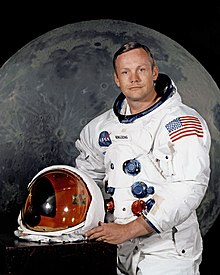Neil Armstrong
From Wikipedia, the free encyclopedia
For other people named Neil Armstrong, see Neil Armstrong (disambiguation).
| Neil Armstrong[1] | |
|---|---|
 Armstrong in July 1969  | |
| NASA Astronaut | |
| Other names | Neil Alden Armstrong |
| Nationality | American |
| Status | Deceased |
| Born | August 5, 1930 Wapakoneta, Ohio, U.S. |
| Died | August 25, 2012 (aged 82) Cincinnati, Ohio, U.S. |
| Previous occupation | Naval aviator, test pilot |
| Time in space | 8 days, 14 hours, 12 minutes, and 30 seconds |
| Selection | 1958 USAF Man In Space Soonest 1960 USAF Dyna-Soar 1962 NASA Group 2 |
| Total EVAs | 1 |
| Total EVA time | 2 hours 31 minutes |
| Missions | Gemini 8, Apollo 11 |
| Mission insignia | |
| Awards | |
Neil Alden Armstrong (August 5, 1930 – August 25, 2012) was an American astronaut and the first person to walk on the Moon. He was also anaerospace engineer, naval aviator, test pilot, and university professor. Before becoming an astronaut, Armstrong was an officer in the U.S. Navy and served in the Korean War. After the war, he earned his bachelor's degree at Purdue University and served as a test pilot at the National Advisory Committee for Aeronautics High-Speed Flight Station, now known as the Dryden Flight Research Center, where he logged over 900 flights. He later completed graduate studies at the University of Southern California.
A participant in the U.S. Air Force's Man in Space Soonest and X-20 Dyna-Soar human spaceflight programs, Armstrong joined the NASA Astronaut Corps in 1962. He made his first space flight, as command pilot of Gemini 8, in 1966, becoming NASA's first civilian astronaut to fly in space. On this mission, he performed the first docking of two spacecraft, with pilot David Scott.[2]
Armstrong's second and last spaceflight was as mission commander of the Apollo 11 moon landing, in July 1969. On this mission, Armstrong andBuzz Aldrin descended to the lunar surface and spent two and a half hours exploring, while Michael Collins remained in lunar orbit in the Command Module. Along with Collins and Aldrin, Armstrong was awarded the Presidential Medal of Freedom by President Richard Nixon; in 1978, PresidentJimmy Carter presented Armstrong the Congressional Space Medal of Honor in 1978; he and his former crewmates received the Congressional Gold Medal in 2009.
Armstrong died in Cincinnati, Ohio, on August 25, 2012, at the age of 82, after complications from coronary artery bypass surgery.[3][4]
Early years
Neil Armstrong was born on August 5, 1930, in Wapakoneta, Ohio, to Stephen Koenig Armstrong and Viola Louise Engel.[5][6] He was of Scottish,Irish, and German ancestry and had two younger siblings, June and Dean. Stephen Armstrong worked as an auditor[7] for the Ohio state government; the family moved around the state repeatedly after Armstrong's birth, living in 20 towns. Neil's love for flying grew during this time, having gotten off to an early start when his father took his two-year-old son to the Cleveland Air Races. When he was five, he experienced his first airplane flight in Warren, Ohio on July 20, 1936 when he and his father took a ride in a Ford Trimotor, also known as the "Tin Goose".[8]
His father's last move was in 1944, back to Neil's birthplace, Wapakoneta, in Auglaize County. Armstrong attended Blume High School and took flying lessons at the county airport. He earned his flight certificate at age 15, before he had a driver's license. Armstrong was active in the Boy Scouts and earned the rank of Eagle Scout. As an adult, he was recognized by the Boy Scouts of America with its Distinguished Eagle Scout Award and Silver Buffalo Award.[9] On July 18, 1969, while flying towards the Moon inside the Columbia, Armstrong greeted the Scouts: "I'd like to say hello to all my fellow Scouts and Scouters at Farragut State Park in Idaho having a National Jamboree there this week; and Apollo 11 would like to send them best wishes". Houston replied: "Thank you, Apollo 11. I'm sure that, if they didn't hear that, they'll get the word through the news. Certainly appreciate that."[10] Among the very few personal items that Neil Armstrong carried with him to the Moon and back was a World Scout Badge.[11]
In 1947, at age 17, Armstrong began studying aeronautical engineering at Purdue University. He was the second person in his family to attend college. He was also accepted to theMassachusetts Institute of Technology (MIT). The only engineer he knew (who had attended MIT) dissuaded him from attending, telling Armstrong that it was not necessary to go all the way toCambridge, Massachusetts, for a good education.[12] His college tuition was paid for under the Holloway Plan: successful applicants committed to two years of study, followed by three years of service in the U.S. Navy, then completion of the final two years of the degree. At Purdue, he earned average marks in his subjects, with a GPA that rose and fell during eight semesters. He was awarded a Bachelor of Science degree in Aeronautical Engineering in 1955, and a Master of Science degree in Aerospace Engineering from the University of Southern California in 1970.[1]Armstrong was later awarded honorary doctorates by several universities.[13]
No comments:
Post a Comment